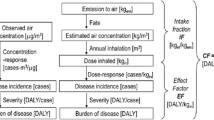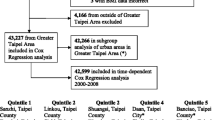Abstract
Studies conducted over the past decades have provided substantial evidence that both the long- and the short-term exposures to ozone and particulate matter are responsible for mortality and cardiopulmonary morbidity. This paper examines the relationship between exposure to ambient concentrations of ozone (O3) and particulate matter with aerodynamic diameter of less than 10 μm (PM10) and public health and provides the quantification of the burden of disease from PM10 and O3-related mortality and morbidity through a Life Cycle Impact Assessment focused on the greater area of Athens, Greece. Thus, characterizations factors (CFs) for human health damage are calculated in 17 sites in Athens, in terms of the annual marginal change in the disability-adjusted life years (DALYs) due to a marginal increase in the ambient concentrations. It is found that the PM10 intake factors range between 1.25 × 10−6 and 2.78 × 10−6, suggesting that 1.25–2.78 μg of PM10 are inhaled by the Athenian population per kg of PM10 in the urban atmosphere. Mortality due to chronic exposure to PM10 has a dominant contribution to years of life lost with values ranging between 6.2 × 10−5 and 1.1 × 10−4. On the other hand, the mortality caused by short-term exposure to O3 is weaker with the CFs ranging between 1.58 × 10−7 years of life lost in the urban/traffic areas and 4.71 × 10−7 years in the suburbs. Finally, it is found that 9,000 DALYs are lost on average in Athens, corresponding to 0.0018 DALYs per person. This is equal to 0.135 DALYs per person over a lifetime of approximately 75 years, assuming constant emission rates for the whole period.



Similar content being viewed by others
References
Anderson, H. R., Atkinson, R. W., Peacock, J. L., Marston, L., & Konstantinou, K. (2004). Meta-analysis of time-series studies and panel studies of particulate matter (PM) and ozone (O 3 ). London: World Health Organization.
Bare, J. C., Norris, G. A., Pennington, D. W., & McKone, T. (2003). TRACI; the tool for the reduction and assessment of chemical and other environmental impacts. Journal of Industrial Ecology, 6(3–4), 49–78.
Bell, M. L., Dominici, F., & Samet, J. M. (2005). A meta-analysis of time-series studies of ozone and mortality with comparison to the national morbidity, mortality, and air pollution study. Epidemiology, 16(4), 436–445.
Chen, L. H., Knutsen, S. F., Shavlik, D., Beeson, W. L., Petersen, F., Ghamsary, M., et al. (2005). The association between fatal coronary heart disease and ambient particulate air pollution: are females at greater risk? Environmental Health Perspectives, 113(12), 1723–1729.
Consoli, F., Allen, D., Boustead, I., Fava, J., Franklin, W., Jensen, A. A., et al. (1993). Guidelines for life-cycle assessment: a “code of practice”. Society of Environmental Toxicology and Chemistry, Seimbra, Portugal, 31 March–3 April 1993.
De Schryver, A. M., Brakkee, K. W., Goedkoop, M. J., & Huijbregts, M. A. J. (2009). Characterization factors for global warming in life cycle assessment based on damages to humans and ecosystems. Environmental Science and Technology, 43(6), 1689–1695.
Economopoulou, A. A., & Economopoulos, A. P. (2002). Air pollution in Athens basin and health risk assessment. Environmental Monitoring and Assessment, 80(3), 277–299.
Huijbregts, M. A. J., & Seppala, J. (2001). Life cycle impact assessment of pollutants causing aquatic eutrophication. The International Journal of Life Cycle Assessment, 6(6), 339–343.
Jerrett, M., Burnett, R. T., Pope, C. A., III, Ito, K., Thurston, G., Krewski, D., et al. (2009). Long-term ozone exposure and mortality. The New England Journal of Medicine, 360(11), 1085–1095.
Kassomenos, P., Papaloukas, C., Petrakis, M., & Karakitsios, S. (2008). Assessment and prediction of short term hospital admissions: the case of Athens, Greece. Atmospheric Environment, 42(30), 7078–7086.
Kassomenos, P., Petrakis, M., Sarigiannis, D., Gotti, A., & Karakitsios, S. (2011). Identifying the contribution of physical and chemical stressors to the daily hospital admission rate implementing an artificial neural network model. Air Quality, Atmosphere and Health, 4(3), 263–272.
Katsouyanni, K., Pantazopoulou, A., Touloumi, G., Tselepidaki, I., Moustris, K., Asimakopoulos, D., et al. (1993). Evidence for interaction between air pollution and high temperature in the causation of excess mortality. Archives of Environmental Health: An International Journal, 48, 235–242.
Katsouyanni, K., Touloumi, G., Samoli, E., Gryparis, A., Le Tertre, A., Monopolis, Y., et al. (2001). Confounding and effect modification in the short-term effects of ambient particles on total mortality: results from 29 European cities within the APHEA2 project. Epidemiology, 12(5), 521–531.
Knol, A. B., & Staatsen, B. A. M. (2005). Trends in the environmental burden of disease in the Netherlands, 1980–2020. Report 500029001, RIVM, Bilthoven, The Netherlands.
Krewitt, W., Trukenmuller, A., Bachmann, T. M., & Heck, T. (2001). Country-specific damage factors for air pollutants. A step towards site dependent life cycle impact assessment. The International Journal of Life Cycle Assessment, 6, 199–210.
Kunzli, N., Kaiser, R., Medina, S., Studnicka, M., Chanel, O., Filliger, P., et al. (2000). Public-health impact of outdoor and traffic-related air pollution: a European assessment. Lancet, 356, 795–801.
Kunzli, N., Medina, S., Kalf, D., Quenel, P., Horak, F., Jr., & Studnicka, M. (2001). Assessment of deaths attributable to air pollution: should we use risk estimates based on time series or on cohort studies? American Journal of Epidemiology, 153(11), 1050–1055.
Le Tertre, A., Medina, S., Samoli, E., Forsberg, B., Michelozzi, P., Boumghar, A., et al. (2002). Short-term effects of particulate air pollution on cardiovascular diseases in eight European cities. Journal of Epidemiology and Community Health, 56(10), 773–779.
Medina, S., Boldo, E., Saklad, M., Niciu, E. M., Krzyzanowski, M., Frank, F., et al. (2005). APHEIS health impact assessment of air pollution and communications strategy. Saint-Maurice: Institut de Veille Sanitaire.
Murray, C. J. L., & Lopez, A. D. (1996). The global burden of disease: a comprehensive assessment of mortality and disability from diseases, injuries, and risk factors in 1990 and projected to 2020. Cambridge: Harvard University Press.
Papadopoulou, N., Tountas, Y., Sypsa, V., Katsouyanni, K., Analitis, A., & Kassomenos, P. (2009). The effect of south winds on daily mortality in Athens. Climate Research, 38, 193–198.
Paschalidou, A. K., & Kassomenos, P. A. (2004). Comparison of air pollutant concentrations between weekdays and weekends in Athens, Greece for various meteorological conditions. Environmental Technology, 25, 1241–1255.
Pattenden, S., Armstrong, B., Milojevic, A., Heal, M. R., Chalabi, Z., Doherty, R., et al. (2010). Ozone, heat and mortality: acute effects in 15 British conurbations. Occupational and Environmental Medicine, 67, 699–707.
Pope, C. A., III, & Dockery, D. W. (2006). Health effects of fine particulate air pollution: lines that connect. Journal of the Air & Waste Management Association, 56, 709–742.
Pye, S., & Watkiss, P. (2005). CAFE CBA: baseline analysis 2000–2020. Didcot: AEA Technology Environment.
US EPA. (1997). Exposure factors handbook. Washington: Office of Research and Development, National Center for Environmental Assessment.
van Zelm, R., Huijbregts, M. A. J., den Hollander, H. A., Van Jaarsveld, H. A., Sauter, F. J., Struijs, J., et al. (2008). European characterization factors for human health damage of PM10 and ozone in life cycle impact assessment. Atmospheric Environment, 42, 441–453.
Author information
Authors and Affiliations
Corresponding author
Rights and permissions
About this article
Cite this article
Kassomenos, P.A., Dimitriou, K. & Paschalidou, A.K. Human health damage caused by particulate matter PM10 and ozone in urban environments: the case of Athens, Greece. Environ Monit Assess 185, 6933–6942 (2013). https://doi.org/10.1007/s10661-013-3076-8
Received:
Accepted:
Published:
Issue Date:
DOI: https://doi.org/10.1007/s10661-013-3076-8




